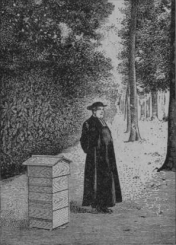
Warré plans
Warré methods
Warré modifications
Warré precursors
Groups / Fora
Google
e-group
Biobees.com
forum
Abbé Warré's book
Beekeeping for All:
Normally the Warré hive is extended by nadiring empty boxes with top-bars and comb guides at the bottom. As boxes at the top become filled with honey and are harvested and the combs rendered for wax a comb renewal process takes place that is built in to the Warré system. No further comb renewal manipulations are required.
Supering has the potential to short circuit this renewal process because, instead of removing boxes of honey in darker combs that have seen several brood cycles, supers full of honey in new comb are removed while most likely leaving old comb on the hive to be reused for brood during a further season.
However, there are two situations where judicious supering may be essential to get the hive to work at all for the benefit of the bees or the beekeeper. One is in highly mellifluous localities where honey binding or constriction of the brood nest prevents normal development of the colony and risks poor wintering due to narrow, vertically elongated brood nests. The other is in localities where nectar flows are relatively limited and timely supering with a shallow box allows the beekeeper to take off a modest honey harvest.
None of the contributors to this page find it necessary to use a queen excluder. Once a honey dome is established in the top box(es) of a normally nadired Warré hive, the queen will rarely cross it to a super empty of comb.
Please bear in mind that the suggestions on this page are context dependent -- all beekeeping is local -- so they might not work out with your climate, forage cycle or type of bee. Warré was beekeeping in northern France, where nectar flows were probably intermediate between the extremes described below. In his book 'Beekeeping for All' he makes no mention of the situations we describe here.
If you are relatively new to the Warré hive, we suggest not using supering al least until you are familiar with both the function of the hive and the dynamics of nectar flows in your locality.
Highly mellifluous localities
Alberta: First evidence of the problem of honey binding in the Warré hive came from John Moerschbacher in Alberta, Canada where in 2009 spectacular honey flows were giving him average harvests of around 70 kg, but in the winter of 2009-10 he lost 14 out of 20 colonies which he partly attributed to 'severe brood nest constriction', in that the space available for the winter cluster to take on its thermally ideal shape was restricted by honey stores round the sides of the boxes.
In April 2010, John Moerschbacher wrote to the Warré Yahoo e-Group (now moved to warrebeekeeping in Googlegroups):
My dead-outs are filled with honey throughout, with only a very long and narrow corridor of brood space in the center of most of the boxes. The broodnest was simply squeezed to the point of being non-viable for a colony going into a long cold winter. The population of bees would have been rapidly dwindling from August onward.
He dealt with the problem by using wider boxes and in addition to normal colony development downwards, he supered during the main nectar flow. Latterly these supers contained frames and either drawn comb or foundation.
The bees need 'ladders' of some kind to ascend to the top of a super to build suspended combs, otherwise they build up from the top-bars of the box below the super, thus making it very difficult to separate the boxes without a great deal of honey spillage. A simple form of ladder is provided by bamboo dowels (skewers, spales) as illustrated in the following photo from a Beeozone video ( https://www.youtube.com/watch?v=LAztzzn-uys&feature=player_embedded ). The bees can be seen on the ladders and the top-bar's waxed starter-strip is already partly built up with comb.
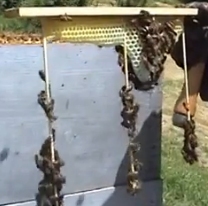
New South Wales: Tim Malfroy, a commercial beekeeper, writes (slightly edited):
in areas with massive and sudden honeyflows [..] I top-super or under super with half-depth boxes with full frames. I call it bee-friendly supering as it relieves the broodnest of nectar congestion. However, you need to stop nadiring momentarily to make it work properly. It's only necessary in areas with these type of flows (some of my Warré colonies produced over 100kg of honeycomb last season). Where the flows are steady, stick to nadiring.
I would recommend trying the half depth boxes as the void above the broodnest is not so great as to disturb the colony, although supering at certain times can trigger swarming. If using full depth boxes I would recommend including four ladder combs.
A number of years ago on a very strong honey flow, I nadired and supered colonies at the same time to see what would happen. The supers were half depth boxes. Twenty-three out of 25 colonies built comb down and ignored the supers. One colony went up in the super, and one colony went both up and down. If you give bees a choice, they will almost always go down.
Supering requires that you have a very strong colony 'boiling' out of the boxes, a big sustained honey flow and warm to hot weather. You also need to stop nadiring momentarily to make it work properly. Ideally, the bees have built comb right to the bottom board. Oh, and wild bees help - they build comb much more vigorously than 'commercial' bees.
If you have a 2-box colony, a half depth super (100mm or 120mm) is placed on top of the brood nest, with starter strips or a ladder comb. If you have a 3-box colony and the top box is stored honey, then you under-super the half depth box, i.e. place it underneath the top box, above the 2 boxes of brood. When the half depth box is drawn out and if the honeyflow continues, you can under-super another half depth box. As mentioned before, the idea behind this is to relieve the broodnest of nectar congestion, give the bees comb to build, and produce some beautiful monofloral honey all at once. The bees will tell you when the honeyflow is finished because they will stop building comb.
If you don't wish to build extra boxes of a different size, an easier method (and one which a lot of my students use in Sydney) is simply to remove individual combs from the top box. Obviously this is easier with open-frames, but can still be done with top-bars. You need to allow the swarm to develop into 3 or 4 full boxes. The top box will be mostly or entirely honey. Just remove a number of combs (just the wall combs, or every 2nd comb), shake bees off at entrance, and replace harvested combs with frames and starter strips. The bees have ladder combs either side and will build new combs there and fill them with honey.
This method means you are not disrupting the broodnest, but opening some space above the broodnest to prevent nectar congestion, allowing bees to build comb, and harvesting small amounts at a time, i.e. 4 kg if both wall combs are harvested, 8kg if every 2nd comb is harvest, which is close to what a half depth box yields. It also means you don't have to lift off a full box of honey.
You can even cut the comb from the frame next to the hive if the honeyflow is on. Just cut it into a bucket with a pocket knife, leaving 1 cm of honeycomb on the top-bar or frame. Put it straight back in the hive and the bees will take to it immediately and start building comb again.
Again, timing is everything here. The benefit of this method is that you're only taking a small harvest and not disrupting the colony too much. If you come back a week or two later and find that the bees haven't built much comb on the frames your returned to the hive, there is still plenty of honey remaining for the colony.
Sometimes new beekeepers taking whole box of honey can lead to disaster. Best to leave a lot of honey for the bees: at least one full depth box, or more.
South of France: Gilles Denis, one of the pioneers of commercial beekeeping with modified Warré hives, recommends routine use of supering. The following paragraphs are notes made from his book La Ruche Warré -- Mode d'Emploi -- Techniqes et Conduite (2008, Gilles Denis, 978-2-9533201):
With a strong colony in conditions of fine weather and abundant forage, Denis suggests supering and creating a 1 cm entrance below the super by means of a wedge front or back. This upper hive entrance, he says, eases access by the foragers, helps temperature control and removal of the excess moisture of incoming nectar. If the good conditions continue, a further super is added. With normal strength colonies and short, abundant flows, for monofloral honeys he supers 2-box hives.
For those who do not know their forage conditions, when a 2-box hive is nearly full he advises enlarging all hives with one nadir and one super. The nadir is to ensure that the laying of the queen is not constricted and the super is for the honey storage. He says there is no need for a queen excluder because the queen will not enter an empty box or cross the layer of honey at the top of the hive being supered. (Warré also asserts that a band of honey acts as a barrier to the queen.) Denis warns that if there is no band of honey there it is not the right time to super.
Denis emphasises that, when supering, it is essential to provide ladders for the bees to reach the top-bars. Otherwise they will construct comb like stalagmites, making it extremely difficult and messy to separate the boxes later. The ladder can comprise a whole empty comb inserted instead of one of the top-bars which have only starter strips or comb guides of some other kind. Ideally there should be two ladders, one to the left and one to the right with a gap of two or three top-bars between them. This way, he says, there is much less adhesion of the honey comb bottoms to the top-bars of the box below. Even so, in his section on harvesting later in the book he advises running a knife between the super and the box below to cut any adhesions. Denis also claims that inserting the wedge to create the upper entrance below the super is also an essential precaution, along with the ladders, for ensuring that the super is harvestable and not welded with honeycomb to the box below.
Localities of limited nectar flows
During the evolution of The People's Hive, Warré had 400 mm deep boxes about which he writes:
the bees did not always fill the top hive-body box with honey. There was sometimes some brood at the bottom of the frames and some honey at the top. Harvesting was difficult. And my helpers frequently said: 'We ought to be able to saw this box in two'.
We have replaced it with two boxes giving the same volume with the same shape. We did the same with the one below. We harvested the boxes full of honey at the top, oneor two, and left the following two boxes for wintering.
The following modification represents a further step in the same direction, i.e. halving the Warré's final box height by providing a 100 mm deep super.
Scotland: Andy Collins writes:
I have taken to routinely supering my strongest colonies with shallow boxes (100 mm or, rarely 150 mm) at (and only at) the start of the exponential growth phase, which is end April, start of May here. I like to think this is bee-friendly supering as well.
I always use one ladder. The bees build comb in the super in about two thirds of cases, but don't always fill it with honey in the first season. There's a tiny window in the super so I can see what's going on without opening again. If only half-filled I'll leave it propolised in place for a second season.
If the hive is chosen for harvest there is always some nice white cut comb honey in the super, and sometimes a second box to take as well. But the main reason I am interested in it is that I am slowly getting the impression that it reduces swarming in large established colonies by giving them other options at swarming time.
The comb-renewal objection to supering [mentioned above] hasn't been a significant issue yet with me. The reason is that whenever it has been possible to harvest a super it has also been possible to take the box below. I only super the strongest colonies.
In other cases (where the super was ignored or filled with comb but not honey) the end-of-season weighing indicated that it would not have been possible to harvest from the hive anyway. This can be a result of swarming, which supering does not always prevent. In those cases the super was simply left propolised in place for a second season, arguably delaying comb renewal by a season.
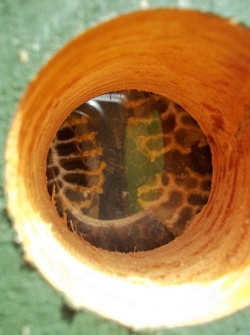 Left: view
through inspection window of one of Andy Collins' supers
Left: view
through inspection window of one of Andy Collins' supers
Below left: Inverted shallow super Below right: comb from super (Photos: Andy Collins)
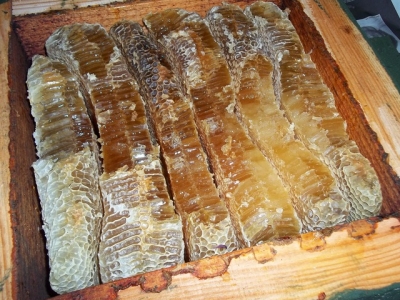
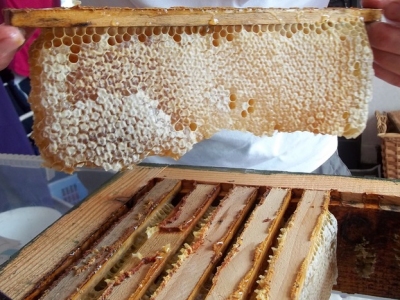
Belgium: Luc P.intens writes:
In localities where nectar flows are relatively limited, timely supering allows the bees to build up stores.
I think it is because where my bees forage, there are no big spring flows -- no willow, no fruit trees. Only in warm spring weather can they get some. My bees 'normally' build up their stores for summer with Robinia and Tilia, and for winter mostly with Impatiens glandulifera and Hedera. These are the only big flows, although there are more smaller ones.
So, when there is a big flow, the bees need to put the nectar above the broodnest. If I do not super at the right moment, my colonies stay small and my number of hives decreases every year. We sometimes forget that a stack of boxes, where the cavity is divided by top-bars, does not have any available space for nectar.